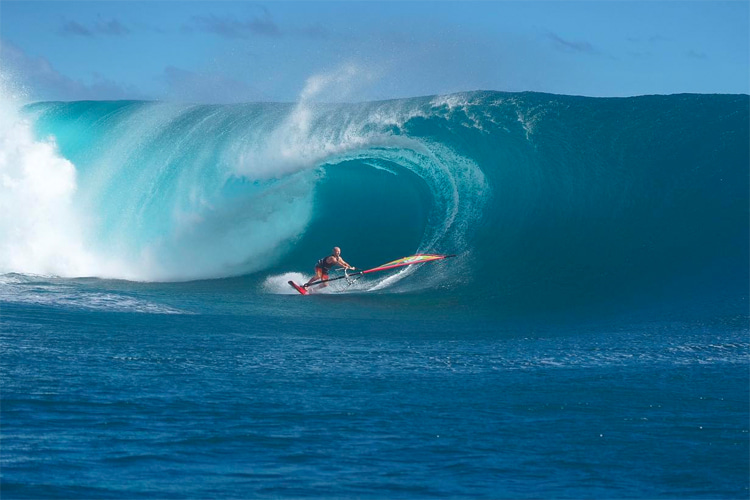2020 has been a disastrous windsurfing year for me. The plan was to embark on a full-season mission on the International Windsurfing Tour (IWT), a long-time dream.
The season pass was signed, the board bags were packed, and flights were booked. Everything was set up.
By the end of February, I was getting ready to fly to Japan for the first stop and then straight after that to Chile.
Two days before my first flight, COVID-19 stormed the world - everything shut down, and the IWT season was canceled.
So, after a huge disappointment, I have to admit that being stuck in Tahiti is not the worst thing in the world, and many people are in a much worse situation than us here.
But the real windsurf disappointment was just about to begin.
We got not more than ten sessions the whole year and went into summertime - December to March - with nothing under the straps.
I was lucky to enjoy a couple of rides in the New Year, but nothing more.
So when we arrived at the beginning of the wind season around April, expectations were high. But then again, nothing, and nothing.
The end of May was coming.
A couple of big swells had arrived recently, and I felt that, as usual, I would have a shot one day with no warm-up session.
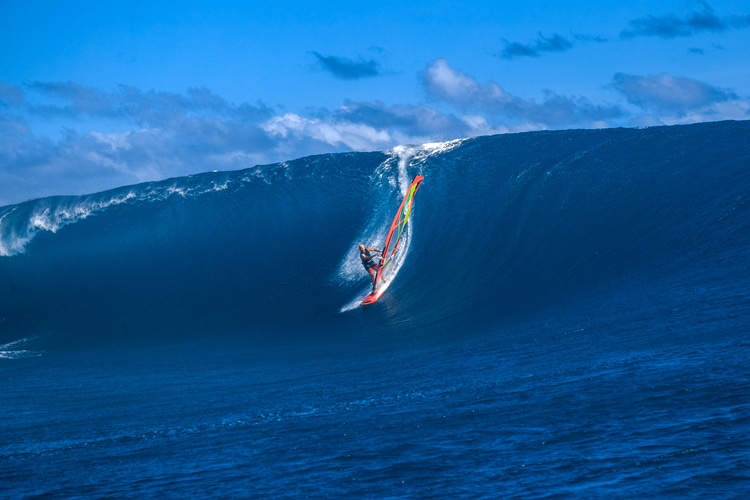
A Promising Teahupoo Forecast
On May 21, a massive swell was forecast with a good angled wind, even though really light for Teahupoo. But still makeable, probably.
The good point was that it was supposed to be on a Saturday, which could give me availability in the afternoon after work because, yes, regular people like myself work.
So at noon, I left the office, drove straight back home, didn't even check the spot, took my Quatro blade and only one sail - no spare one because that is typically the kind of day where you get into trouble.
And in order to save equipment for the season, because I have no way to go to Maui for the moment and get some, I didn't want to let me the opportunity to break more gear.
It was a clever thing to do, as things went that way.
When I got to the line-up on my jet ski, my friend Gael Vaast, the father of surfing prodigy Kauli and my best windsurf mate, was ready with his camera.
"Go, Charli! I'll take pictures," Vaast shouted.
Gael only had one sail left, so he opted to stay safe.
The waves were bloody big and west, almost tow-in size. The sky was clear, and the wind was well orientated, but light, really light.
We had just the wind that allows you to give it a try - and you won't accept not doing so - but still not enough to be comfortable.
So, precisely the most nerve-wracking scenario.
I didn't take the time to think about it too much. I was not going to change my mind and rigged my 4.7-meter Fringe X Pro.
Suddenly, I realized there were spiderwebs in my foot straps - not a good sign!
There were only two surfers in the line-up because of the high tide and wind, which is good to give you a good sight of the take-off zone, and few boats in the channel watching the show.
These two aspects are good because, for windsurfing there, you really need to have a better idea of the take-off and the channel zones to find your line.
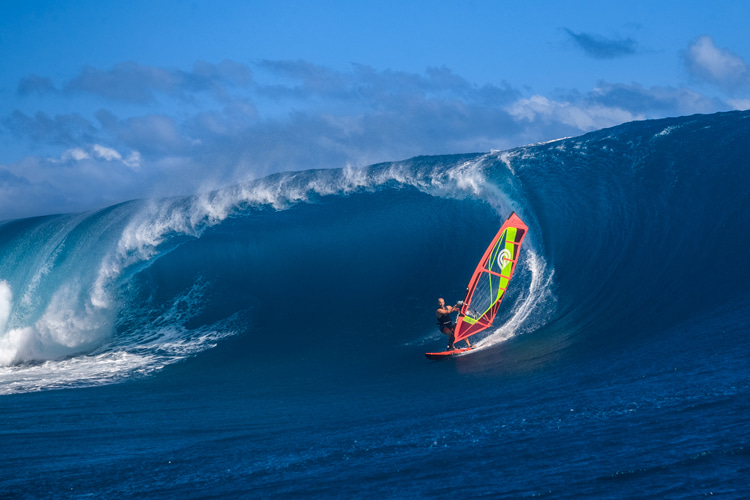
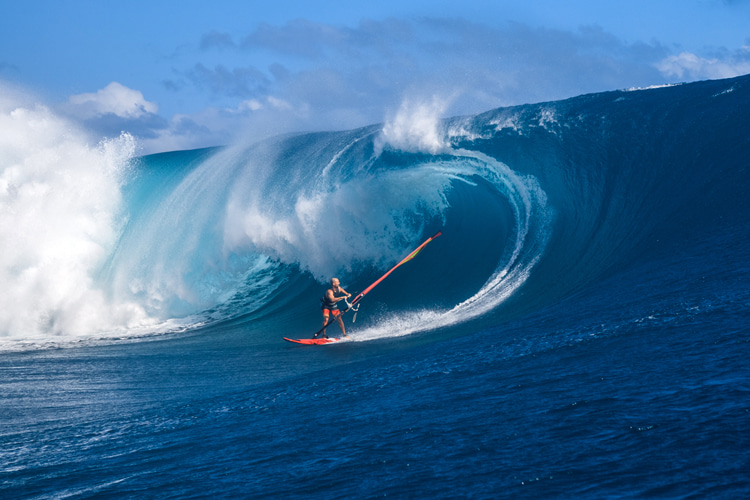
Getting Acquainted With the Beast
I quickly got my first warm-up wave to clean my gear from insects and dust and then went out to find a good and bigger one.
I was ready for the announced peak of swell at 3.3 meters, 17 seconds. But it was actually bigger.
You could see only big lines marching from the horizon. It was pumping and consistent. So, I unplugged the brain and went for a bomb.
On my first shot on my way back, I tried to get planing as close as I could from the surfers, about 20 meters out.
The wind speed was not enough, so I tried to get even closer for another one.
I still didn't make it. So, I got a last-second turnaround, literally on the top of the lip of this monster.
The vision was nuts. Standing with your gear four meters above the reef, with your heels pretty much in the air, gave me goosebumps.
So the game plan today was to go for a surfer take-off style technique.
That meant you'd have to go with perfect timing on your way back in to be able to connect the wave, pull on the sail, and put your feet into the straps right next to the surfers with a wave already bending.
It's pretty technical stuff, trust me.
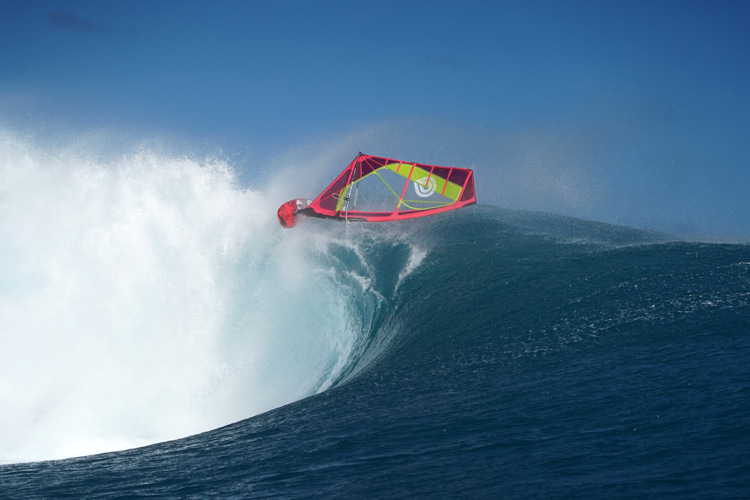
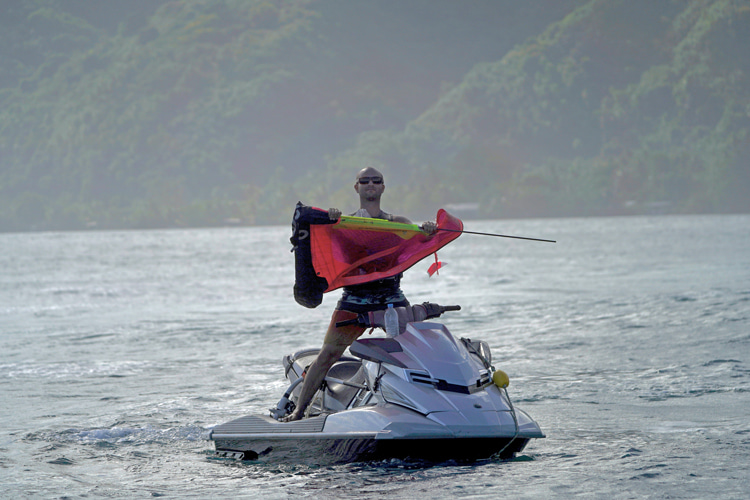
The Ultimate Windsurfing Wipeout
I found the one: a big, west-oriented wave with a little gust. I almost air-dropped it.
With no wind on the bottom of the wave face, my sail inverted toward me because of the wind speed.
I had to let the pressure go by pulling on my backhand so that the sail opened. The boom reached my low back at that point, making the turn impossible.
I went a bit longer, straight in front of the wave, to get wind in the right direction, and went on the opposite rail with my toes.
That's when you have a look at the wave that finally came alive and realize it is really west, and I am losing speed with no power coming in.
I opened the end of my turn to optimize my escape and gained a few meters that saved my equipment at the end.
During the process, I put in place my sea snake diving skills - head first, below the sail, at the right angle - to penetrate as deep as possible, considering the size, speed, and position of the wave.
I slapped my left face and ear and feared for my dear life. I was surprised and really glad that both of us made it.
I resurfaced safely a few seconds later and saw my equipment intact, floating ten meters away.
I have to say I felt like Teahupoo's luckiest survivor! It is not the most glorious title I could dream of, but a life-changing event that day for sure.
The second wave came, swallowed my gear in front of me, and I swam back to the ski.
I barely made it, but I was OK for a quick ski ride over the reef to reach inside the lagoon and pick up the pieces.
I found my board, base, extension, and mast intact, together, and still rigged.
The boom extension was cut apart, and I saw just a little piece of tissue at the bottom to remind me that a sail was there before.
I kept searching all around for an hour with another friend but found nothing.
The beast was hungry and took her meal. She loves Goya equipment even more than we do, with a bit of salt and french meat.
That was my 30-minute session of the last six months - Teahupoo life.
Words by Charles Vandemeulebroucke | Windsurfer
